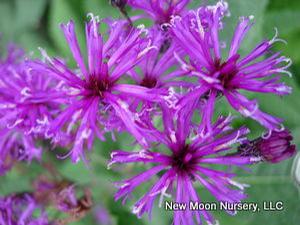New Moon Nurseries

New York ironweed is for wet areas, naturally found in wet meadows and fields. Attracts pollinators.
Vernonia noveboracensis
New York ironweed
Native to North America
FIRST IMPRESSIONS: Vernonia noveborecensis is a tall robust perennial wildflower with numerous lance shaped leaves. In late summer plants are crowned by large corymbs of royal purple disc florets. Butterflies and other pollinators flock to the blooms. This species thrives in wet open woods or in sunny gardens with moist soil.
HABITAT & HARDINESS: Vernonia noveborecensis occurs from New Hampshire to Kentucky and south to Georgia, Alabama and the Florida panhandle.
Plants are indigenous to wet meadows, moist pastures, stream banks, low woods, marshes, ditches and wet roadsides.
This species is hardy from USDA Zones 5-9.
PLANT DESCRIPTION: Vernonia noveborecensis is an upright perennial wildflower with many stem leaves and no basal leaves.
Blades are oval to lance shaped and up to 8” long and 3” across. Leaves are toothed with pointed tips. Petioles may be short or absent. The lower leaf surface is light green and often pubescent.
From mid-summer until autumn, plants bear terminal flat topped flower corymbs. The inflorescences are composed of clusters of deep purple disc florets.
Each floret matures into a brown to gray nutlet with a bristly brown to purple colored pappus.
Plants are 4-8’ tall with an average 2-4’ spread.
CULTURAL & MAINTENANCE NEEDS: Vernonia noveborecensis prefers sunny wet sites or gardens with average moist acidic soil. Plants tolerate clay soils, alkaline pH and some drought.
This species is pest resistant but foliage is occasionally nibbled by deer and other herbivores.
In the wild plants occur in wet sites but in garden situations this one can grow in well-drained soil or tolerate some drought.
LANDSCAPE USES: In bloom, Vernonia noveborecensis is a dramatic Accent for a Wildlife Garden or Meadow. Plants are lovely in combination with native grasses and golden fall flowers. Plants are also used as Butterfly Nectar Plants, Cut Flowers or as part of a Grouping or Mass Planting. This wildflower has Showy Blooms and provides Erosion Control. It can be used in Cottage Gardens, Low Maintenance Plantings or Perennial Borders.
COMPANION & UNDERSTUDY PLANTS: Try pairing Vernonia noveborecensis with Andropogon virginicus, Aster puniceus, Eupatorium colestinum, Eupatoriium fistulosum, Helianthus angustifolius, Hibiscus coccineus, Liatris spicata or Panicum virgatum.
Vernonia glauca is slightly shorter and less tolerant of wet soil but would be a worthy substitute in some situations.
TRIVIA: Unlike most other members of the Aster Family, Vernonia spp. flowers are composed only of disc florets with no rays.
Flowers attract bevies of butterflies, skippers, moths and native bees.
Vernonia glauca is similar in appearance to Vernonia noveborecensis. V. glauca is shorter, more tolerant of dry sites and generally has leaves with glaucous white undersides. The two species also differ in the color of the pappus. A pappus is the modified calyx that occurs at the base of the floret and persists as an attachment to the seed. The pappus of Vernonia spp. looks like a cluster of bristly hairs. V. glauca has a straw colored or almost white pappus while V. noveborecensis has a darker brownish or purple pappus.
The generic name honors English botanist, bryologist and entomologist William Vernon who collected in Maryland during 1698. The specific epithet refers to the state of New York where the species was probably first identified.
Height:
4-8 ftSpread:
2-4 ftSpacing:
2-4 ftUSDA Hardiness Zone:
5-9Bloom Color:
PurpleVernonia noveboracensis Characteristics
Attracts Wildlife
- Butterflies
- Pollinators
Attributes
- East-Coast Native
- Dried Flower
- Cut Flower
- Clay Soil
- Bog
- Rain Garden
- Naturalizing
- Long Blooming
Exposure
- Full Sun to Partial Shade
Deer Resistant
- Deer Resistant
Flowering Months
- October
- September
- August
- July
Foliage Color
- Green
Growth Rate
- Medium
Juglans nigra Tolerance (Black Walnut)
- Yes
Salt Tolerance
- Medium
Season of Interest (Foliage)
- Summer
- Spring
- Fall
Soil Moisture Preference
- Moist to Wet
Interesting Notes:
For more information on this plant, visit the USDA PLANTS Database: http://plants.usda.gov/java/profile?symbol=VENO